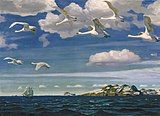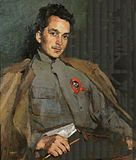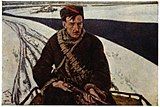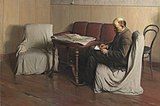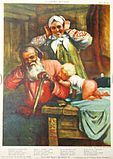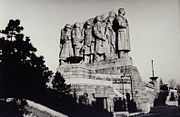User:Kspepple/sandbox
The examples and perspective in this article may not represent a worldwide view of the subject. (May 2014) |
Socialist realism is a style of realistic art that was developed in the Soviet Union and became a dominant style in various other socialist countries. Socialist realism is characterized by the glorified depiction of communist values, such as the emancipation of the proletariat, in a realistic manner.[1] Although related, it should not be confused with social realism, a broader type of art that realistically depicts subjects of social concern.[2] Socialist realism was the predominate form of art in the Soviet Union from its development in the early 1920s to its eventual fall from popularity in the late 1960s.[3] While other countries have employed a prescribed cannon of art, socialist realism in Russia persisted longer and was more restricted than elsewhere in Europe. [4]
Development
[edit]Socialist realism was developed by many thousands of artists, across a diverse empire, over several decades.[5] Early examples of realism in Russian art include the work of the Peredvizhnikis, Jacques-Louis David and Ilya Yefimovich Repin. While these works do not have the same political connotation, they exhibit the techniques exercised by their successors. After the Bolsheviks took control of Russia on October 25, 1917 there was a marked shift in artistic styles. There had been a short period of artistic exploration in the time between the fall of the Tsar and the rise of the Bolsheviks, but in 1917 Russian artists began to return to more traditional forms of art and painting.[6] Shortly after Bolsheviks took control, Anatoly Lunacharsky was appointed as head of Narkompros, the People's Commissariat for Enlightenment. [7] This put Lunacharsky in the position of deciding the direction of art in the newly created Soviet state. Lunacharsky created a system of aesthetics based on the human body that would become the main component of socialist realism for decades to come. He believed that "the sight of a healthy body, intelligent face or friendly smile was essentially life-enhancing."[8] He concluded that art had a direct effect on the human organism and under the right circumstances that effect could be positive. By depicting "the perfect person", Lunacharsky believed art could educate citizens on how to be the perfect Soviets.[9]
There were two main groups debating the fate of Soviet art; futurist and traditionalist. Futurist, many of whom had been creating abstract or leftist art before the Bolsheviks, believed communism required a complete rupture from the past and therefore so did Soviet art.[10] Traditionalist believed in the importance of realistic representations of every day life. Under Lenin's rule and the New Economic Policy, there was a certain amount of private commercial enterprise, allowing both the futurist and the traditionalist to produce their art for individuals with capital.[11] But by 1928, the Soviet government had enough strength and authority to end private enterprises thus ending support for fringe groups such as the futurists. At this point, although the term "socialist realism" was not being used, its defining characteristics became the norm.[12]
The first time the term "socialist realism" was officially used was in 1932. The term was settled upon in meetings that included the highest level politicians, including Stalin himself.[13] Maxim Gorky, a proponent of literary socialist realism, published a famous article titled "Socialist Realism" in 1933 and by 1934 the term's etymology was traced back to Stalin.[14] During the Congress of 1934 four guidelines were laid out for socialist realism.[15] The work must be:
- Proletarian: art relevant to the workers and understandable to them.
- Typical: scenes of every day life of the people.
- Realistic: in the representational sense.
- Partisan: supportive of the aims of the State and the Party.
Characteristics
[edit]The purpose of socialist realism was to limit popular culture to a specific, highly regulated faction of creative expression that promoted Soviet ideals.[16] The party was of the upmost importance and was always to be favorably featured. The key concepts that developed assured loyalty to the party, "partiinost'" (party-mindedness), "ideinost" (idea- or ideological-content), "klassovost" (class content), "pravdivost" (truthfulness).[17] There was a prevailing sense of optimism, socialist realism's function was to show the ideal Soviet society. Not only was the present gloried, but the future was also supposed to be depicted in an agreeable fashion. Because the present and the future were constantly idolized, socialist realism had a sense of forced optimism. Tragedy and negativity were not permitted, unless they were shown in a different time or place. This sentiment created what would later be dubbed "revolutionary romanticism".[18]
Revolutionary romanticism elevated the common worker, whether factory or agricultural, by presenting his life, work, and recreation as admirable. Its purpose was to show how much the standard of living had improved thanks to the revolution. Art was used as educational information. By illustrating the party's success, artists were showing their viewers that sovietism was the best political system. Art was also used to show how Soviet citizens should be acting. The ultimate aim was to create what Lenin called "an entirely new type of human being": The New Soviet Man. Art (especially posters and murals) was a way to instill party values on a massive scale. Stalin described the socialist realist artists as "engineers of souls".[19]
Common images used in socialist realism were, flowers, sunlight, the body, youth, flight, industry, and new technology.[20] These poetic images were used to show the utopianism of communism and the Soviet state. Art became more than an aesthetic pleasure, instead it served a very specific function. Soviet ideals placed functionality and work above all else, therefore for art to be admired it must serve a purpose. Georgi Plekhanov, a Marxist theoretician, states that art is only useful if it serves society "There can be no doubt that art acquired a social significance only in so far as it depicts, evokes, or conveys actions, emotions and events that are of significance to society."[21]
The artist could not, however, portray life just as they saw it; because anything that reflected poorly on Communism had to be omitted. People who could not be shown as either wholly good or wholly evil could not be used as characters.[22] This was reflective of the Soviet idea that morality is simple, things are either right or wrong. This view on morality called for idealism over realism[23] Art was filled with health and happiness; paintings showed busy industrial and agricultural scenes, and sculptures depicted workers, sentries, and schoolchildren.[24]
Creativity was not an important part of socialist realism, it was actually rejected. The styles used in creating art during this period were those that would produce the most realistic results. Painters would depict happy, muscular peasants and workers in factories and collective farms; during the Stalin period, they produced numerous heroic portraits of the dictator to serve his cult of personality – all in the most realistic fashion possible.[25] The most important thing for a socialist realist artist was not artistic integrity, rather adherence to party doctrine.[26]
Important groups
[edit]Association of Artists of Revolutionary Russia (AKhRR) was established in 1922 and was one of the most influential artist groups in the USSR. AKhRR worked to truthfully document contemporary life in Russia by utilizing "heroic realism".[27] The term "heroic realism" was beginning of the socialist realism archetype. AKhRR was sponsored by influential government officials such as Leon Trotsky and carried favor with the Red Army[28] In 1928 the AKhRR was renamed to Association of Artists of the Revolution (AKhR) in order to include the rest of the Soviet states. At this point the group had begun participating in state promoted mass forms of art like murals, jointly made paintings, advertisement production and textile design.[29] The group was disbanded April 23, 1932 by the decree “On the Reorganization of Literary and Artistic Organizations”[30]
Society of Easel Painters (OSt)
[edit]While the Society of Easel Painters (OSt) was also focused on the glorification of the revolution they, as per their name, worked individually as easel painters. The most common subjects of the OSt's works fit with the developing socialist realism trope. Their paintings consisted of sport and battle, industry and modern technology.[31] OSt broke up in 1931 due to some members' demand to transition to collective print and poster work.[32] Some prominent members include Aleksandr Deyneka, Yuri Pimanov, Aleksandr Labas, Pyotr Vilyams, all of whom were students or ex-students of Moscow's art school, Vkhutemas.[33]
Impact
[edit]
The impact of socialist realism art can still be seen and felt decades after it was no longer the only state supported style. Even before the end of the USSR in 1991, the government had been loosening its hold on censorship. After Stalin's death in 1953, Nikita Khrushchev began to condemn the previous regime's practice of excessive restrictions. This freedom allowed artists to begin experimenting with new techniques, but the shift was not immediate. It was not until the ultimate fall of Soviet rule that artists were completely free. Many socialist realism tendencies prevailed until the mid-to-late 1990s and early 2000s.[34]
In the 1990s many Russian artists used socialist realism characteristics in an ironic fashion.[35] This was a complete rupture from what existed only a couple of decades before. Once artists broke from the socialist realism mold there was a significant power shift. Artist began including subjects that could not exist according to Soviet ideals. Now that the power over appearances was taken away from the government, artists achieved a level of authority that had not existed since the early 20th century.[36] In the decade immediately after the fall of the USSR, artists represented socialist realism and the Soviet legacy as a traumatic event. By the next decade there was a unique sense of detachment.[37]
Western cultures often do not look at socialism realism positively. Democratic countries view the art produced during this period of repression as a lie.[38] Non-Marxist cultures view communism as a form of totalitarianism that smothers artistic expression and therefore retards the progress of culture.[39] Western cultures often look at socialist realistic works as propaganda rather than art.
Notable works and artists
[edit]Maxim Gorky's novel Mother is usually considered[by whom?] to have been the first socialist-realist novel.[citation needed] Gorky was also a major factor in the school's rapid rise, and his pamphlet, On Socialist Realism, essentially lays out the needs of Soviet art. Other important works of literature include Fyodor Gladkov's Cement (1925), Nikolai Ostrovsky's How the Steel Was Tempered and Mikhail Sholokhov's two volume epic, Quiet Flows the Don (1934) and The Don Flows Home to the Sea (1940). Yury Krymov's novel Tanker "Derbent" (1938) portrays Soviet merchant seafarers being transformed by the Stakhanovite movement.
Martin Andersen Nexø developed socialist realism in his own way. His creative method featured a combination of publicistic passion, a critical view of capitalist society, and a steadfast striving to bring reality into accord with socialist ideals. The novel Pelle, the Conqueror is considered to be a classic of socialist realism.[citation needed] The novel Ditte, Daughter of Man had a working-class woman as its heroine. He battled against the enemies of socialism in the books Two Worlds, and Hands Off!.
The novels of Louis Aragon such as The Real World depicts the working class as a rising force of the nation. He published two books of documentary prose, The Communist Man. In the collection of poems A Knife in the Heart Again, Aragon criticizes the penetration of American imperialism into Europe. The novel The Holy Week depicts the artist's path toward the people against a broad social and historical background.
Hanns Eisler composed many workers' songs, marches, and ballads on current political topics such as Song of Solidarity, Song of the United Front, and Song of the Comintern. He was a founder of a new style of revolutionary song for the masses. He also composed works in larger forms such as Requiem for Lenin. Eisler's most important works include the cantatas German Symphony, Serenade of the Age and Song of Peace. Eisler combines features of revolutionary songs with varied expression. His symphonic music is known for its complex and subtle orchestration.
Closely associated with the rise of the labor movement was the development of the revolutionary song, which was performed at demonstrations and meetings. Among the most famous of the revolutionary songs are The Internationale and Warszawianka. Notable songs from Russia include Boldly, Comrades, in Step, Workers' Marseillaise, and Rage, Tyrants. Folk and revolutionary songs influenced the Soviet mass songs. The mass song was a leading genre in Soviet music, especially during the 1930s and the war. The mass song influenced other genres, including the art song, opera, and film music. The most popular mass songs include Dunaevsky's Song of the Homeland, Blanter's Katiusha, Novikov's Hymn of Democratic Youth of the World, and Aleksandrov's Sacred War.
In the early 1930s, Soviet filmmakers applied socialist realism in their work. Notable films include Chapaev, which shows the role of the people in the history-making process. The theme of revolutionary history was developed in films such as The Youth of Maxim, by Grigori Kozintsev and Leonid Trauberg, Shchors by Dovzhenko, and We are from Kronstadt by E. Dzigan. The shaping of the new man under socialism was a theme of films such as A Start Life by N. Ekk, Ivan by Dovzhenko, Valerii Chkalov by M. Kalatozov and the film version of Tanker "Derbent" (1941). Some films depicted the part of peoples of the Soviet Union against foreign invaders: Alexander Nevsky by Eisenstein, Minin and Pozharsky by Pudvokin, and Bogdan Khmelnitsky by Savchenko. Soviet politicians were the subjects in films such as Yutkevich's trilogy of movies about Lenin.
Socialist realism was also applied to Hindi films of the 1940s and 1950s.[citation needed] These include Chetan Anand's Neecha Nagar (1946), which won the Grand Prize at the 1st Cannes Film Festival, and Bimal Roy's Two Acres of Land (1953), which won the International Prize at the 7th Cannes Film Festival.
Paintings
[edit]-
A. Rylov. In the Blue Expanse (1918)
-
S. Malyutin. Portrait of writer Furmanov
-
S. Malyutin. Partisan
-
I. Brodsky. Lenin in Smolny (1930)
-
"They are hearing Moscow" (poster).
-
N. Kasatkin. Pioneer-girl with book (1926)
Sculptures
[edit]-
Socialist-Realist allegories surrounding the Palace of Culture and Science in Warsaw.
See also
[edit]- Social realism
- Capitalist realism
- Heroic realism
- Socialist realism in Romania
- Socialist realism in Poland
- All-Union art exhibition (Moscow, 1957)
Notes
[edit]- ^ Korin, Pavel, “Thoughts on Art”, Socialist Realism in Literature and Art. Progress Publishers, Moscow, 1971, p. 95.
- ^ Todd, James G. "Social Realism". Art Terms. Museum of Modern Art, 2009.
- ^ Ellis, Andrew. Socialist Realisms: Soviet Painting 1920-1970. Skira Editore S.p.A., 2012, p. 20
- ^ Valkenier, Elizabeth. Russian Realist Art. Ardis, 1977, p. 3.
- ^ Ellis, Andrew. Socialist Realisms: Soviet Painting 1920-1970. Skira Editore S.p.A., 2012, p. 17
- ^ Ellis, Andrew. Socialist Realisms: Soviet Painting 1920-1970. Skira Editore S.p.A., 2012, p. 21
- ^ Ellis, Andrew. Socialist Realisms: Soviet Painting 1920-1970. Skira Editore S.p.A., 2012, p. 17
- ^ Ellis, Andrew. Socialist Realisms: Soviet Painting 1920-1970. Skira Editore S.p.A., 2012, p. 21
- ^ Ellis, Andrew. Socialist Realisms: Soviet Painting 1920-1970. Skira Editore S.p.A., 2012, p. 21
- ^ Ellis, Andrew. Socialist Realisms: Soviet Painting 1920-1970. Skira Editore S.p.A., 2012, p. 21
- ^ Ellis, Andrew. Socialist Realisms: Soviet Painting 1920-1970. Skira Editore S.p.A., 2012, p. 22
- ^ Ellis, Andrew. Socialist Realisms: Soviet Painting 1920-1970. Skira Editore S.p.A., 2012, p. 23
- ^ Ellis, Andrew. Socialist Realisms: Soviet Painting 1920-1970. Skira Editore S.p.A., 2012, p. 37
- ^ Ellis, Andrew. Socialist Realisms: Soviet Painting 1920-1970. Skira Editore S.p.A., 2012, p. 37
- ^ Juraga, Dubravka and Booker, Keith M. Socialist Cultures East and West. Praeger, 2002, p.68
- ^ Nelson, Cary and Lawrence, Grossberg. Marxism and the Interpretation of Culture. University of Illinois Press, 1988, p. 5
- ^ Ellis, Andrew. Socialist Realisms: Soviet Painting 1920-1970. Skira Editore S.p.A., 2012, p. 38
- ^ Ellis, Andrew. Socialist Realisms: Soviet Painting 1920-1970. Skira Editore S.p.A., 2012, p. 38
- ^ Overy, Richard. The Dictators: Hitler's Germany, Stalin's Russia. W. W. Norton & Company, 2004, p. 354
- ^ Ellis, Andrew. Socialist Realisms: Soviet Painting 1920-1970. Skira Editore S.p.A., 2012, p. 38
- ^ Schwartz, Lawrence H. Marxism and Culture. Kennikat Press, 1980, p. 110
- ^ Frankel, Tobia. The Russian Artist. Macmillan Company, 1972, p. 125
- ^ Overy, Richard. The Dictators: Hitler's Germany, Stalin's Russia. W. W. Norton & Company, 2004, p. 354
- ^ Stegelbaum, Lewis and Sokolov, Andrei. Stalinism As A Way Of Life. Yale University Press, 2004, p. 220
- ^ Juraga, Dubravka and Booker, Keith M. Socialist Cultures East and West. Praeger, 2002, p.45
- ^ Nelson, Cary and Lawrence, Grossberg. Marxism and the Interpretation of Culture. University of Illinois Press, 1988, p. 5
- ^ Ellis, Andrew. Socialist Realisms: Soviet Painting 1920-1970. Skira Editore S.p.A., 2012, p. 22
- ^ Ellis, Andrew. Socialist Realisms: Soviet Painting 1920-1970. Skira Editore S.p.A., 2012, p. 22
- ^ Ellis, Andrew. Socialist Realisms: Soviet Painting 1920-1970. Skira Editore S.p.A., 2012, p. 35
- ^ Ellis, Andrew. Socialist Realisms: Soviet Painting 1920-1970. Skira Editore S.p.A., 2012, p. 35
- ^ Nelson, Cary and Lawrence, Grossberg. Marxism and the Interpretation of Culture. University of Illinois Press, 1988, p. 93
- ^ Nelson, Cary and Lawrence, Grossberg. Marxism and the Interpretation of Culture. University of Illinois Press, 1988, p. 93
- ^ Nelson, Cary and Lawrence, Grossberg. Marxism and the Interpretation of Culture. University of Illinois Press, 1988, p. 92
- ^ Evangeli, Aleksandr. "Echoes of Socialist Realism in Post-Soviet Art", Socialist Realisms: Soviet Painting 1920-1970. Skira Editore S.p.A., 2012, p. 218
- ^ Evangeli, Aleksandr. "Echoes of Socialist Realism in Post-Soviet Art", Socialist Realisms: Soviet Painting 1920-1970. Skira Editore S.p.A., 2012, p. 218
- ^ Evangeli, Aleksandr. "Echoes of Socialist Realism in Post-Soviet Art", Socialist Realisms: Soviet Painting 1920-1970. Skira Editore S.p.A., 2012, p. 221
- ^ Evangeli, Aleksandr. "Echoes of Socialist Realism in Post-Soviet Art", Socialist Realisms: Soviet Painting 1920-1970. Skira Editore S.p.A., 2012, p. 223
- ^ Juraga, Dubravka and Booker, Keith M. Socialist Cultures East and West. Praeger, 2002, p.12
- ^ Schwartz, Lawrence H. Marxism and Culture. Kennikat Press, 1980, p. 4

